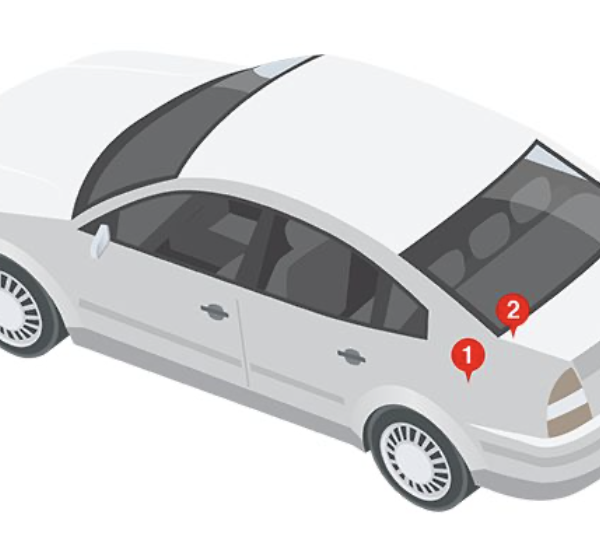How to Repair Clearcoat
Steps for a DIY Clearcoat Job

Clearcoat is your car’s first line of defense from body rust and corrosion. It protects your color paint from being damaged and prevents the metal body of your car being exposed and made vulnerable to rust. Cuts, dings, chips, scrapes can break down your car’s protective layer of clear coat paint. If you don’t maintain a layer, the damage can spread.
In addition to protecting your car’s body, Clearcoat keeps your car looking sharp. Before we get into how to repair Clearcoat, let’s consider all the ways Clearcoat can be damaged.
Sources of Damage to Clearcoat:
- Physical abrasion, cuts, dings, and chips
- UV radiation
- Exposure to chemicals
- Improper application
There are three main ways Clearcoat breaks down: one-time physical damage, slow, cumulative damage from the sun, and chemical damage from a variety of sources. Physical sources of damage are straightforward – Clearcoat can be scraped off with a scratch in a parking lot, in an accident or if a rock flies up from the road and takes out a chip. UV radiation from the sun is a slow process that happens over years in which layers of paint to heat up and slowly separate. Chemical damage happens over an in between timeline of hours, days, and weeks. For all these sources of damage, the repair process is similar. Though for cumulative UV damage and sometimes chemical damage, the application area is typically larger, and may require sandblasting and painting whole panels at a time with Aerosol Clearcoat paint.
What Chemicals Damage Car Paint?
Powerful solvents like paint thinner are an obvious source of damage to your car’s finish, but let’s look at some less noticeable sources of damage.
Common chemicals that damage car paint:
- Bugs
- Tree sap
- Dust
- Gasoline
- Bird poop
- Acid rain
Bug guts can be quite acidic and quickly eat through paint in a couple of days. If you have a bunch stuck to your hood, it’s time to go get a car wash.
Tree sap is quite tricky to remove and only gets harder to remove with time so don’t ignore it! Use a mild solvent like WD-40 or nail polish remover to get it off, then promptly wash the area to prevent the solvent from doing additional damage. You may need to polish the area afterward because sap can leave a dull patch.
Dust can combine with rain to create a mild acid that slowly eats away at your car’s finish. Go to the car wash regularly to reduce this.
When filling up, spilled gasoline can damage your car’s finish. Clean it off if you spill and be careful at the pump!
Bird poop is very caustic and can eat through paint in a matter of days. Don’t ignore it!
Acid rain is something that you may not even realize is happening until it is too late. Do general preventative maintenance by washing your car and keeping it waxed to reduce the effects of acid rain.
How to Repair Clearcoat
Keeping your car clear and out of the sun will prevent the worst of the damage, but even then some dings and scratches will happen. When that happens, be prepared to fix it up by keeping touch up accessories on hand.
Tools Needed for Clearcoat Paint Repair
- Clearcoat – in brush form, paint pen or aerosol spray
- Wax remover
- Tack cloth
- 1500 grit and 2000 grit sandpaper
- Polishing compound
How to Repair Clearcoat
- Prep area by wet sanding with 1500 grit sandpaper
- Remove any wax and oil from area with wax removing wipes
- Wipe area with tack cloth then apply clear coat paint and let dry
- Repeat wiping and painting for two more layers of paint, letting it dry between each coat
- (Optional) Wet sand the area with a 2000 grit sandpaper
- Wait 24 hours, then buff the area with polishing compound
Side-bar – Upgrading Clearcoat to 2K

When using a Clearcoat, you have 2 main options – 1K Clearcoat and 2K Clearcoat. 1K means one component, 2K means two components – paint and hardener – that are combined when you start to use it. Because of the hardener, 2K will dry faster and harder, resulting in a more professional finish that lasts longer, but once you start to use it, you will only be able to use it for 12 hours or less because it will dry and cure inside of the can, making it impossible to use again.
When using a Clearcoat, you have 2 main options – 1K Clearcoat and 2K Clearcoat. 1K means one component, 2K means two components – paint and hardener – that are combined when you start to use it. Because of the hardener, 2K will dry faster and harder, resulting in a more professional finish that lasts longer, but once you start to use it, you will only be able to use it for 12 hours or less because it will dry and cure inside of the can, making it impossible to use again.
Choosing the Right Finish: Matte, Gloss, Semi-Gloss and More
When choosing a Clearcoat, make sure you choose the right finish because if you choose the wrong one, the texture of your repair will visibly stand out no matter how much you sand it and buff it! The most common is gloss Clearcoat, but there are several other matte Clearcoat options often found on motorcycles, trim, Mercedes-Benz cars, and BMW cars.
Clear coat finish options:
- Gloss
- Matte
- Semi-gloss
- Flat
- Satin
- Eggshell
Preventing Future Damage to Clearcoat
You can reduce UV damage to your car’s Clearcoat by washing it regularly and keeping it out of the elements in a garage or under a cover.
Regular waxing also reduces damage. Waxing a minimum of two times a year can fill in tiny scratches that are not visible to the naked eye and prevent them from growing into bigger, more noticeable blemishes.
For more help with how to repair Clearcoat, check out our How to Use Your Combo Tool video to see how to properly paint a touch up job.

 Cart
Cart
 Help Desk
Help Desk






